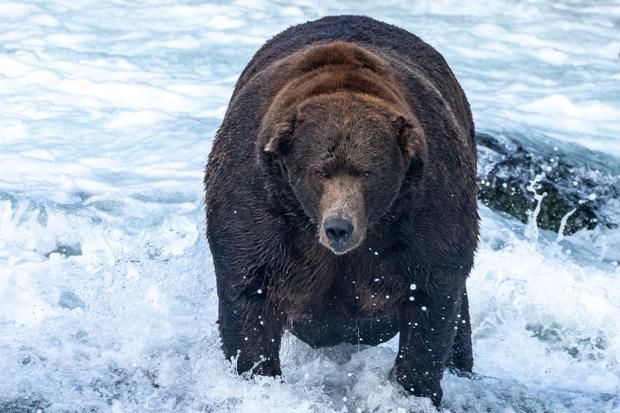Fat Bear Week is about to begin. Meet this year's contenders for the fattest bear in an Alaska national park.
The bears are back – bigger, hungrier and hopefully, fatter than ever. Fat Bear Week will launch this week at Katmai National Park and Preserve in Alaska, bringing some of the park's most beloved bears to the spotlight to eat their way to get the crown for fattest bear before it's time to hibernate for the winter.
Here's what to know about the annual event.
What is Fat Bear Week?
The annual event is meant to celebrate the brown bears who reside along Brooks River, a waterway that's part of "one of the last great salmon runs left on earth," according to the National Park Service. Park officials say they've been spending the whole summer "fattening up to survive winter hibernation." Now, some of them will be part of Fat Bear Week's bracket-style competition, in which fans worldwide vote for their favorite bear.
Fat Bear Week was launched by the National Park Service in 2014 with just a single celebratory day – Fat Bear Tuesday. But the event was so successful that it became a dedicated week in 2015.
"Fat Bear Week highlights the accomplishments of these burly bruins and shines a spotlight on the healthy ecosystem in which they can thrive," a news release from the National Park Service says. "... Without the pristine Brooks Rivers ecosystem to support an abundant salmon run, there would be no Fat Bear champions."
When is Fat Bear Week?
The bracket matchups will be unveiled on Oct. 2, Fat Bear Week organizers said, with voting taking place from Oct. 4 to Oct. 10 at fatbearweek.org. This year's winner will be announced on Oct. 10, and given a "hero's send off into hibernation."
"And what do the winners get?" organizers asked in their news release. "Six months of restful solitude. But the real winners are all the healthy bears and all those who participate in the web's favorite week of the year."
Who are the Fat Bear Week 2023 contestants?
Last year, voting season was shrouded in Fat Bear Week controversy after organizers said that a spam campaign attempted to name a false winner.
"Like bears stuff their face with fish, our ballot box, too, has been stuffed," the park service said. "It appears someone has decided to spam the Fat Bear Week poll, but fortunately it is easy for us to tell which votes are fraudulent."
Those votes attempted to give the win to Bear 435, but Bear 747 ultimately took the crown — and is attempting to defend his title. Here are the other contenders:
32 Chunk
Explore.org describes Chunk as a "large adult male with narrowly-set eyes" and says he has a "distinctive scar across his muzzle." He was first identified by the park in 2007, when was just a "chunky-looking 2.5-year-old bear" that wouldn't really challenge other males. But this summer, officials say he started to use "his size and confidence to his advantage."
Even crown-holder 747 "deferred fishing spots and salmon to him," they said, and he is now "ranked among the river's largest and most dominant males."
128 Grazer
Grazer is an adult female "with a long straight muzzle and conspicuously blond ears," according to Explore.org. She's lived at the Brooks River since she was a cub in 2005, and is known for being one of the area's "best anglers." And it's for good reason, too. Explore.org says she has "successfully raised two litters of cubs" and will often confront and attack much larger adult males to keep them safe.
"In summer 2023, many other bears remembered her reputation and Grazer maintained a high level of dominance even though she was single," officials said. "....Grazer's combination of skill and toughness makes her one of Brooks River's most formidable, successful, and adaptable bears."
151 Walker
Contender 151 Walker is a large adult male known to park officials since he was just 2 1/2 years old in 2009. He's known for ranking "high" in the bear hierarchy at Brooks Rivers, and Explore.org says he "shows much less tolerance for other bears" – and even displaces others from his fishing spots.
164 Bucky
This medium-sized adult male is known for his ingenuity – instead of competing for fishing spots, he's created his own at the base of Brooks Falls in a spot where "no other bear – currently or in the recent past – has tried to fish consistently."
284 Electra
This adult "perky"-eared female became a prominent figure at Brooks River after separating from her mother in 2011. She's had two known litters of cubs – including fellow competitor 901, who was part of her 2016 litter.
"Bear 284's legacy, like that of her mother and her grandmother, was cemented as she protected her cubs and showed them the skills necessary to survive," contest officials say. "She's part of a legacy that spans generations."
402
Bear 402 is more than just a large adult female. According to Explore.org, there are few others who can rival her "maternal experience," as she has at least eight litters of cubs, "more than any other bear currently at Brooks River." But that has come at a heartbreaking loss for the bear, who lost "entire litters," according to officials.
"One of the cubs from her most recent litter disappeared in 2022. This summer, she continues to care for her single yearling," officials said. "Her life illustrates the triumphs and difficulties of a long-lived mother bear."
428
Bear 428, 128 Grazer's offspring, is known for being a "pudgy" subadult bear who has "followed her mother's lead" in learning to fish and fend for herself." This year was the first time officials said she managed to navigate Brooks River without her mother's guidance.
435 Holly
This large adult female is known for resembling the "shape and color of a lightly toasted marshmallow" and having a life filled with "hardship, surprises, and success." Not only did she raise an injured cub in 2007, but seven years later, she took in a long cub and raised it alongside her own, ensuring that they both became "successful adults."
This 2019 Fat Bear Week champion is now a bachelorette bear, but officials say it's "afforded her the opportunity to concentrate on her own needs."
480 Otis
Otis is a large adult male who was just between 4 to 6 years old when he was first found in 2001, and now, he's one of the oldest male bears. As such, he has been forced to become somewhat of a fighter, facing competition from younger males for fishing spots as his teeth deteriorate to "poor condition." Officials say he is missing two of his canine teeth and that many of his others are "greatly worn.."
Despite having won "more Fat Bear titles than anyone," starting with the inaugural championship in 2014, this year has been a bit of a struggle for Otis. Officials say when he arrived at Brooks River in late July, he looked like he hadn't "eaten much of anything" and was "emaciated with hip and rib bones visible under his skin."
747
Reigning Fat Bear Week champ Bear 747 is a large adult male – so big, in fact, that officials say "few brown bears ever grow as large." He was found in 2004 as a young bear who couldn't manage to compete with the larger bears for fish, but since then, he's grown to be a "giant," at one point weighed an estimated 1,400 pounds.
901
Bear 901 is an adult female who made her return to Brooks River earlier this year with three cubs. Unfortunately, one of those cubs disappeared in mid-September while she was fishing in the lower parts of the river.
"Raising cubs is difficult for mother bears, and first-time mothers are particularly challenged to provision the family with food while keeping them safe," Explore.org says.
















